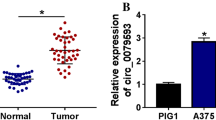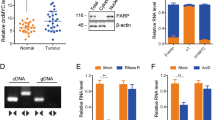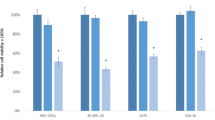Abstract
Late-stage melanoma is refractory to current therapies. MicroRNAs (miRNAs) can modulate many physiological and pathological processes of melanoma. Studies have demonstrated that miR-137 acts as a tumor suppressor by inhibiting the proliferation of melanoma cells through targeting multiple mRNAs. The glyoxalase system member glyoxalase 1 (GLO1) is the principal scavenging enzyme of methylglyoxal (MG), a toxic byproduct of glycolysis. Using 35S in vivo/vitro labelling analysis for dynamic proteomics (SiLAD), we found that miR-137 downregulated the expression of GLO1 in melanoma cells. Bioinformatics analysis predicted that GLO1 is a direct target of miR-137. This was validated by dual luciferase reporter assay. Quantitative RT-PCR (qRT-PCR) and western blot analysis indicated that miR-137 could decrease endogenous GLO1 expression. Furthermore, siRNA targeting of GLO1 mimicked inhibition of melanoma cell proliferation caused by miR-137 overexpression. Re-expression of GLO1 was able to restore miR-137-mediated suppression of melanoma cell proliferation. Therefore, these results suggest that miR-137 inhibits the proliferation of melanoma cells by targeting GLO1.
Similar content being viewed by others
References
Althoff, K., Beckers, A., Odersky, A., Mestdagh, P., Köster, J., Bray, I.M., Bryan, K., Vandesompele, J., Speleman, F., Stallings, R.L., Schramm, A., Eggert, A., Sprüssel, A., and Schulte, J.H. (2013). MiR-137 functions as a tumor suppressor in neuroblastoma by downregulating KDM1A. Int J Cancer 133, 1064–1073.
Bair Iii, W.B., Cabello, C.M., Uchida, K., Bause, A.S., and Wondrak, G.T. (2010). GLO1 overexpression in human malignant melanoma. Melanoma Res 20, 85–96.
Bemis, L.T., Chen, R., Amato, C.M., Classen, E.H., Robinson, S.E., Coffey, D.G., Erickson, P.F., Shellman, Y.G., and Robinson, W.A. (2008). MicroRNA-137 targets microphthalmia-associated transcription factor in melanoma cell lines. Cancer Res 68, 1362–1368.
Chang, X., Zhang, H., Lian, S., and Zhu, W. (2016). miR-137 suppresses tumor growth of malignant melanoma by targeting aurora kinase A. Biochem Biophys Res Commun 475, 251–256.
Chen, C.C., Liu, T.Y., Huang, S.P., Ho, C.T., and Huang, T.C. (2015). Differentiation and apoptosis induction by lovastatin and ?-tocotrienol in HL-60 cells via Ras/ERK/NF-?B and Ras/Akt/NF-?B signaling dependent down-regulation of glyoxalase 1 and HMG-CoA reductase. Cell Signal 27, 2182–2190.
Chen, D.H., Xu, W.D., Bales, E., Colmenares, C., Conacci-Sorrell, M., Ishii, S., Stavnezer, E., Campisi, J., Fisher, D.E., Ben-Ze’ev, A., and Medrano, E.E. (2003). SKI activates Wnt/beta-catenin signaling in human melanoma. Cancer Res 63, 6626–6634.
Chen, Q., Chen, X., Zhang, M., Fan, Q., Luo, S., and Cao, X. (2011a). miR-137 is frequently down-regulated in gastric cancer and is a negative regulator of Cdc42. Dig Dis Sci 56, 2009–2016.
Chen, X., Wang, J., Shen, H., Lu, J., Li, C., Hu, D.N., Dong, X.D., Yan, D., and Tu, L.L. (2011b). Epigenetics, microRNAs, and carcinogenesis: functional role of microRNA-137 in uveal melanoma. Invest Ophthalmol Vis Sci 52, 1193–1199.
Cheng, J., Zhou, L., Xie, Q.F., Xie, H.Y., Wei, X.Y., Gao, F., Xing, C.Y., Xu, X., Li, L.J., and Zheng, S.S. (2010). The impact of miR-34a on protein output in hepatocellular carcinoma HepG2 cells. Proteomics 10, 1557–1572.
Deng, Y., Deng, H., Bi, F., Liu, J., Bemis, L.T., Norris, D., Wang, X.J., and Zhang, Q. (2011). MicroRNA-137 targets carboxyl-terminal binding protein 1 in melanoma cell lines. Int J Biol Sci 7, 133–137.
Fabian, M.R., Sonenberg, N., and Filipowicz, W. (2010). Regulation of mRNA Translation and Stability by microRNAs. Annu Rev Biochem 79, 351–379.
Gatenby, R.A., and Gillies, R.J. (2004). Why do cancers have high aerobic glycolysis? Nat Rev Cancer 4, 891–899.
Gray-Schopfer, V., Wellbrock, C., and Marais, R. (2007). Melanoma biology and new targeted therapy. Nature 445, 851–857.
Guo, J., Xia, B., Meng, F., and Lou, G. (2013). miR-137 suppresses cell growth in ovarian cancer by targeting AEG-1. Biochem Biophys Res Commun 441, 357–363.
Hao, S., Luo, C., Abukiwan, A., Wang, G., He, J., Huang, L., Weber, C.E.M., Lv, N., Xiao, X., Eichmüller, S.B., and He, D. (2015). miR-137 inhibits proliferation of melanoma cells by targeting PAK2. Exp Dermatol 24, 947–952.
He, J., Hao, S., Zhang, H., Guo, F., Huang, L., Xiao, X., and He, D. (2015). Chronological protein synthesis in regenerating rat liver. Electrophoresis 36, 1622–1632.
Hu, X., Yang, X., He, Q., Chen, Q., and Yu, L. (2014). Glyoxalase 1 is up-regulated in hepatocellular carcinoma and is essential for HCC cell proliferation. Biotechnol Lett 36, 257–263.
Li, P., Ma, L., Zhang, Y., Ji, F., and Jin, F. (2014). MicroRNA-137 down-regulates KIT and inhibits small cell lung cancer cell proliferation. Biomed Pharmacother 68, 7–12.
Liu, M., Lang, N., Qiu, M., Xu, F., Li, Q., Tang, Q., Chen, J., Chen, X., Zhang, S., Liu, Z., Zhou, J., Zhu, Y., Deng, Y., Zheng, Y., and Bi, F. (2011). miR-137 targets Cdc42 expression, induces cell cycle G1 arrest and inhibits invasion in colorectal cancer cells. Int J Cancer 128, 1269–1279.
Lu, J., Getz, G., Miska, E.A., Alvarez-Saavedra, E., Lamb, J., Peck, D., Sweet-Cordero, A., Ebert, B.L., Mak, R.H., Ferrando, A.A., Downing, J.R., Jacks, T., Horvitz, H.R., and Golub, T.R. (2005). MicroRNA expression profiles classify human cancers. Nature 435, 834–838.
Lu, Z.J., Liu, S.Y., Yao, Y.Q., Zhou, Y.J., Zhang, S., Dai, L., Tian, H.W., Zhou, Y., Deng, H.X., Yang, J.L., and Luo, F. (2011). The effect of miR-7 on behavior and global protein expression in glioma cell lines. Electrophoresis 32, 3612–3620.
Luo, C., Tetteh, P.W., Merz, P.R., Dickes, E., Abukiwan, A., Hotz-Wagenblatt, A., Holland-Cunz, S., Sinnberg, T., Schittek, B., Schadendorf, D., Diederichs, S., and Eichmüller, S.B. (2013). miR-137 inhibits the invasion of melanoma cells through downregulation of multiple oncogenic target genes. J Invest Dermatol 133, 768–775.
Rabbani, N., and Thornalley, P.J. (2012). Methylglyoxal, glyoxalase 1 and the dicarbonyl proteome. Amino Acids 42, 1133–1142.
Ryan, B.M., Robles, A.I., and Harris, C.C. (2010). Genetic variation in microRNA networks: the implications for cancer research. Nat Rev Cancer 10, 389–402.
Segura, M.F., Hanniford, D., Menendez, S., Reavie, L., Zou, X., Alvarez-Diaz, S., Zakrzewski, J., Blochin, E., Rose, A., Bogunovic, D., Polsky, D., Wei, J., Lee, P., Belitskaya-Levy, I., Bhardwaj, N., Osman, I., and Hernando, E. (2009). Aberrant miR-182 expression promotes melanoma metastasis by repressing FOXO3 and microphthalmia-associated transcription factor. Proc Natl Acad Sci USA 106, 1814–1819.
Sun, G., Cao, Y., Shi, L., Sun, L., Wang, Y., Chen, C., Wan, Z., Fu, L., and You, Y. (2013). Overexpressed miRNA-137 inhibits human glioma cells growth by targeting Rac1. Cancer Biother Radiopharm 28, 327–334.
Thornalley, P.J. (2008). Protein and nucleotide damage by glyoxal and methylglyoxal in physiological systems—role in ageing and disease. Drug Metabol Drug Interact 23, 125–150.
Tsao, H., Chin, L., Garraway, L.A., and Fisher, D.E. (2012). Melanoma: from mutations to medicine. Genes Dev 26, 1131–1155.
Ventura, A., and Jacks, T. (2009). MicroRNAs and cancer: short RNAs go a long way. Cell 136, 586–591.
Xiu, Y., Liu, Z., Xia, S., Jin, C., Yin, H., Zhao, W., and Wu, Q. (2014). MicroRNA-137 upregulation increases bladder cancer cell proliferation and invasion by targeting PAQR3. PLoS ONE 9, e109734.
Xu, J.F., Huang, Z.Y., Lin, L., Fu, M.Q., Gao, Y.H., Shen, Y.L., Zou, Y.Z., Sun, A.J., Qian, J.Y., and Ge, J.B. (2014). miR-210 over-expression enhances mesenchymal stem cell survival in an oxidative stress environment through antioxidation and c-Met pathway activation. Sci China Life Sci 57, 989–997.
Zhang, J., Xiao, X.J., and Liu, J. (2015). The role of circulating miRNAs in multiple myeloma. Sci China Life Sci 58, 1262–1269.
Zhang, Z., Chen, J., Guo, F., He, L., Wu, Y., Zeng, C., Xiao, X., and He, D. (2008). A high-temporal resolution technology for dynamic proteomic analysis based on 35S labeling. PLoS ONE 3, e2991.
Zhu, S., Si, M.L., Wu, H., and Mo, Y.Y. (2007). MicroRNA-21 targets the tumor suppressor gene tropomyosin 1 (TPM1). J Biol Chem 282, 14328–14336.
Acknowledgements
This work was supported by the Special Funds for Major State Basic Research of China (2011CB915504), Coalition for National Science Funding (31171371 (2011–2015) to Dacheng He), and the German Cancer Aid (Melanoma Research Network) to Dr. Stefan B. Eichmüller.
Author information
Authors and Affiliations
Corresponding author
Rights and permissions
About this article
Cite this article
Lv, N., Hao, S., Luo, C. et al. miR-137 inhibits melanoma cell proliferation through downregulation of GLO1. Sci. China Life Sci. 61, 541–549 (2018). https://doi.org/10.1007/s11427-017-9138-9
Received:
Accepted:
Published:
Issue Date:
DOI: https://doi.org/10.1007/s11427-017-9138-9




